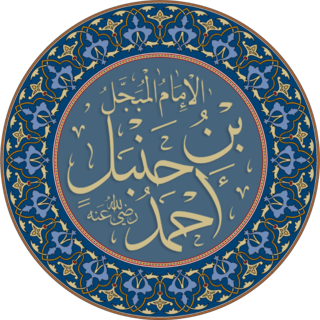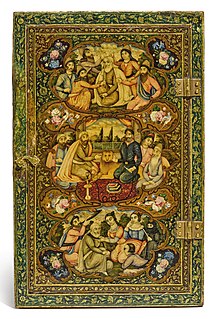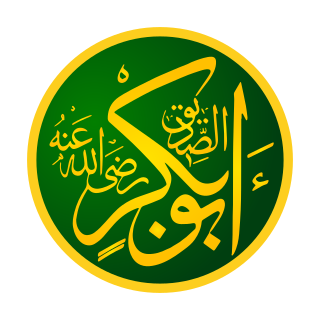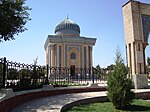Related Research Articles

Sufism, also known as Tasawwuf (ٱلتَّصَوُّف), is a mystic body of religious practice within Islam characterized by a focus on Islamic spirituality, ritualism, asceticism and esotericism.

Aḥmad ibn Ḥanbal, or Ibn Ḥanbal, was an Arab Muslim jurist, theologian, ascetic, hadith traditionist, and founder of the Hanbali school of Sunni jurisprudence — one of the four major orthodox legal schools of Sunni Islam.

Jaʿfar ibn Muḥammad al-Ṣādiq, commonly known as Ja'far al-Ṣādiq, was an 8th-century Muslim scholar. He was the 6th Imam and founder of the Ja'fari school of jurisprudence according to Twelver and Isma'ili Shi'ites. The traditions recorded from al-Sadiq are said to be more numerous than all hadiths recorded from all other Shia imams combined. He is also important to Sunnis as a teacher to the Sunni scholars Abu Hanifah and Malik ibn Anas and as a transmitter of Sunni hadith. Ja'far al-Sadiq also figures prominently in the initiatic chains of many Sufi orders. Despite the fact that a wide range of works in religious as well as scientific disciplines were attributed to him, no works penned by Ja'far himself remain extant.

Al-Hallaj or Mansour Hallaj was a Persian mystic, poet and teacher of Sufism. He is best known for his saying: "I am the Truth" (Ana'l-Ḥaqq), which many saw as a claim to divinity, while others interpreted it as an instance of annihilation of the ego, allowing God to speak through him. Al-Hallaj gained a wide following as a preacher before he became implicated in power struggles of the Abbasid court and was executed after a long period of confinement on religious and political charges. Although most of his Sufi contemporaries disapproved of his actions, Hallaj later became a major figure in the Sufi tradition.

ʿAlī ibn ʿUthmān al-Hujwīrī, better known as ʿAlī Hujwīrī and reverentially as Dātā Ganj Bakhsh, was an 11th-century Persian Sunni Muslim mystic, theologian, and preacher. He is well known for composing the Kashf al-Maḥjūb, which is considered the earliest formal treatise on Sufism in Persian.

Abū Yazīd Ṭayfūr bin ʿĪsā bin Surūshān al-Bisṭāmī (al-Basṭāmī), commonly known in the Iranian world as Bāyazīd Bisṭāmī, was a Persian Sufi from north-central Iran. Known to future Sufis as Sultān-ul-Ārifīn, Bisṭāmī is considered to be one of the expositors of the state of fanā, the notion of dying in mystical union with Allah. Bastami was famous for "the boldness of his expression of the mystic’s complete absorption into the mysticism." Many "ecstatic utterances" have been attributed to Bisṭāmī, which lead to him being known as the "drunken" or "ecstatic" school of Islamic mysticism. Such utterance may be argued as, Bisṭāmī died with mystical union and the deity is speaking through his tongue. Bisṭāmī also claimed to have ascended through the seven heavens in his dream. His journey, known as the Mi'raj of Bisṭāmī, is clearly patterned on the Mi'raj of the Islamic prophet Muhammad. Bisṭāmī is characterized in three different ways: a free thinking radical, a pious Sufi who is deeply concerned with following the sha'ria and engaging in "devotions beyond the obligatory," and a pious individual who is presented as having a dream similar to the Mi'raj of Muhammed. The Mi'raj of Bisṭāmī seems as if Bisṭāmī is going through a self journey; as he ascends through each heaven, Bisṭāmī is gaining knowledge in how he communicates with the angels and the number of angels he encounters increases.

Shams al-Dīn Abū ʿAbd Allāh Muḥammad ibn Abī Bakr ibn Ayyūb al-Zurʿī l-Dimashqī l-Ḥanbalī , commonly known as Ibn Qayyim al-Jawziyya or Ibn al-Qayyim for short, or reverentially as Imam Ibn al-Qayyim in Sunni tradition, was an important medieval Islamic jurisconsult, theologian, and spiritual writer. Belonging to the Hanbali school of orthodox Sunni jurisprudence, of which he is regarded as "one of the most important thinkers," Ibn al-Qayyim was also the foremost disciple and student of Ibn Taymiyyah, with whom he was imprisoned in 1326 for dissenting against established tradition during Ibn Taymiyyah's famous incarceration in the Citadel of Damascus.

Abū Dāwūd (Dā’ūd) Sulaymān ibn al-Ash‘ath ibn Isḥāq al-Azdī al-Sijistānī, commonly known simply as Abū Dāwūd al-Sijistānī, was a scholar of prophetic hadith who compiled the third of the six "canonical" hadith collections recognized by Sunni Muslims, the Sunan Abu Dāwūd. He was a Persian of Arab descent.

Junayd of Baghdad was a Persian mystic and one of the most famous of the early Islamic saints. He is a central figure in the spiritual lineage of many Sufi orders.
Abū Bakr Muhammad ibn al-Ḥasan ibn Duraid al-Azdī al-Baṣrī ad-Dawsī Al-Zahrani, or Ibn Duraid, a leading grammarian of Baṣrah, was described as "the most accomplished scholar, ablest philologer and first poet of the age", was from Baṣra in the Abbasid era. Ibn Duraid is best known today as the lexicographer of the influential dictionary, the Jamharat al-Lugha. The fame of this comprehensive dictionary of the Arabic language is second only to its predecessor, the Kitab al-'Ayn of al-Farahidi.

Abu 'Abd Allah Muhammad ibn al-Khafif (882-982) known as al-Shaykh al-Kabir or Shaykh al-Shirazi was a Persian mystic and sufi from Iran. He is credited with bringing Sufism (tasawwuf) to Shiraz.

Abu Ismaïl Abdullah al-Herawi al-Ansari or Abdullah Ansari of Herat (1006–1088) also known as Pir-i Herat "Sage of Herat", was a Muslim Sufi saint who lived in the 11th century in Herat. One of the outstanding figures of 5th/11th century Khorasan, Ansari was a commentator of the Qur'an, scholar of the Hanbali school of thought (madhhab), traditionalist, polemicist, and spiritual master, known for his oratory and poetic talents in Arabic and Persian.

Abū Bakr is an Arabic given name meaning "Father of a Young Camel" that is widely used by Sunni Muslims.
Tazkirat al-Awliyā – variant transliterations: Tazkirat al-Awliyā`, Tadhkirat al-Awliya, Tazkerat-ol-Owliya, Tezkereh-i-Evliā etc., – is a hagiographic collection of ninety-six Sufi saints and their miracles (Karamat) by the twelfth–thirteenth-century Persian poet and mystic, Farīd al-Dīn ‘Aṭṭar. ‘Aṭṭar's only surviving prose work comprises 72-chapters, beginning with the life of Jafar Sadiq, the Sixth Shia Imam, and ending with the Sufi Martyr, Mansur Al-Hallaj's.
Sahl al-Tustarī or Sahl Shushtarī according to Persian custom, born Abū Muḥammad Sahl ibn ʿAbd Allāh, was a Persian Sunni Muslim scholar and early classical Sufi mystic. He founded the Salimiyah Muslim theological school, which was named after his disciple Muhammad ibn Salim.

Abū al-Ḥakam ʿAbd al-Salām b. ʿAbd al Raḥmān b. Abī al-Rijāl Muḥammad b. ʿAbd al-Raḥmān al-Lakhmī al-Ifrīqī al-Ishbīlī was one of the greatest Sufi figures of Al-Andalus and a hadith scholar. He spread his teachings in the first half of the 12th century.
Abū Ḥātim Aḥmad ibn Ḥamdān al-Rāzī was a Persian Ismaili philosopher of the 9th century, who died in 322 AH. He was also the Da'i al-du'at (chief missionary) of Ray and the leader of the Ismaili da'wah in Central Persia.
Abu Bakr Muhammad ibn Dawud al-Zahiri, Abū Bakr Muḥammad ibn Dāwūd al-Iṣbahānī, also known as Avendeath, was a medieval theologian and scholar of the Arabic language and Islamic law. He was one of the early propagators of his father Dawud al-Zahiri's method in jurisprudence, Zahirism.
Abu Muhammad Ruwaym bin Ahmad was an early Muslim jurist, ascetic, saint and reciter of the Qur'an. He was one of the second generation of practitioners of Sufism (tasawwuf).

Shaykh Muhibullah Allahabadi, or Muhibb ullah Ilahabadi was a Sufi scholar who was active in Allahabad in northern India during the reign of the Mughul emperor Shah Jahan. He is noted as a leading proponent of the Sufi doctrine of Wahdat al-Wujud, sometimes called "Oneness of Being". Some Sufis consider that he was a saint.
References
- ↑ Frye, R.N., ed. (1975). The Cambridge history of Iran (Repr. ed.). London: Cambridge U.P. p. 461. ISBN 978-0-521-20093-6.
The authors of most of these works, which have been the mainstay of Sufi literature to this day within the khanaqahs, were Persians, such men as Kalabadhi, Sarraj, Makki, Sulami and Abu Nu'aim.
- ↑ Madelung, Wilferd (1988). Religious Trends in Early Islamic Iran. Persian Heritage Foundation. p. 47.
